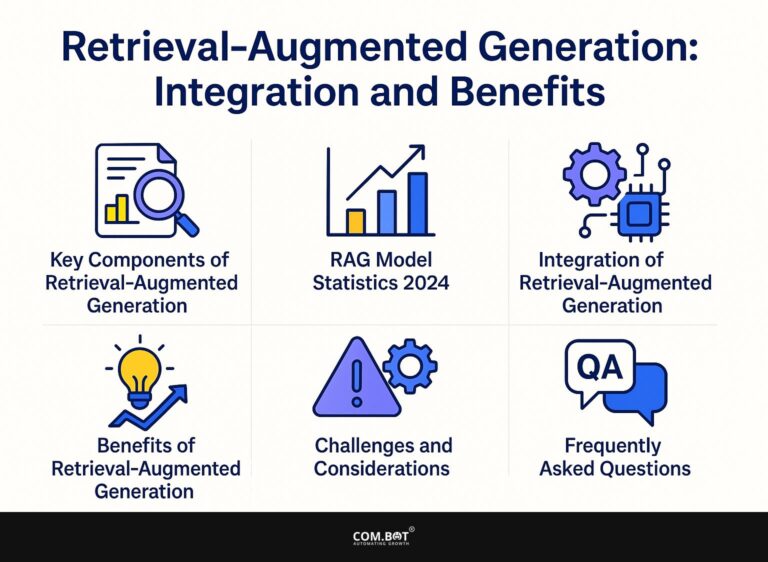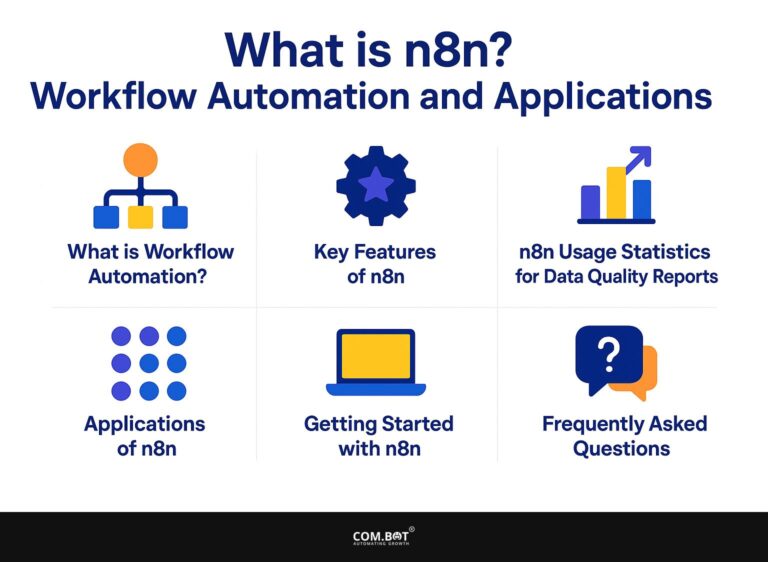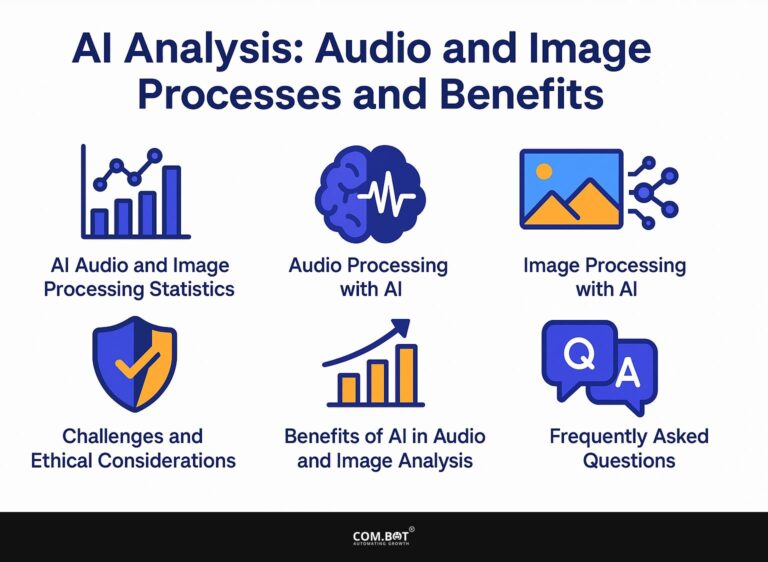Managing High Volume with AI Bots: Scalability and Efficiency
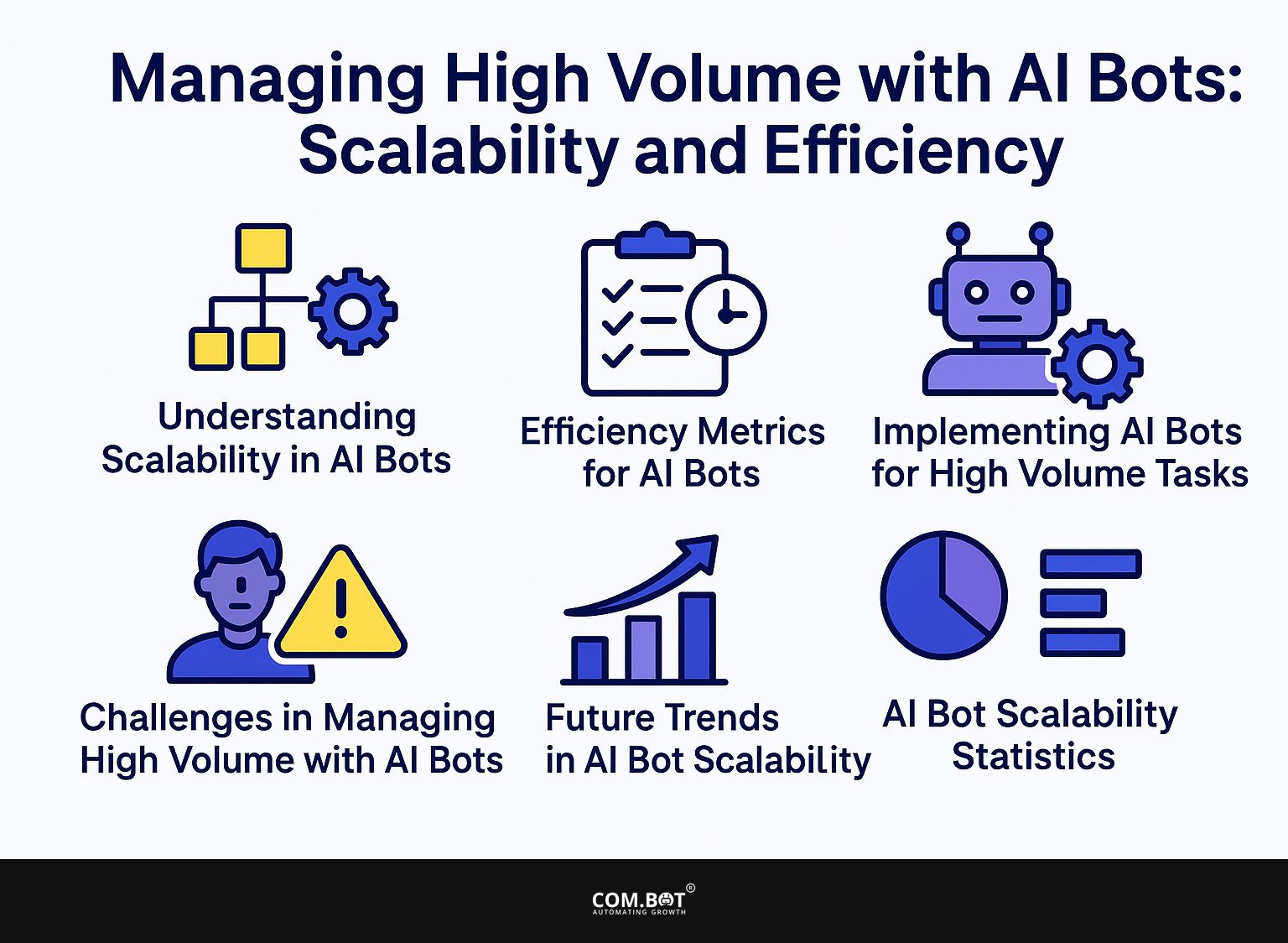
Handling large numbers of user interactions quickly is important in today’s digital world, and artificial intelligence is at the forefront. With AI tools such as those provided by CustomGPT.ai on cloud platforms, businesses can improve how they handle data and easily grow their operations.
This article looks at how AI bots can change how we handle big tasks, offering useful information on their effectiveness and upcoming improvements, helping you make processes and user experiences better.
Key Takeaways:
- Scalability matters for AI bots dealing with many tasks, allowing them to manage big volumes of data and requests smoothly and well.
- Measuring efficiency through KPIs and real-time monitoring is important for continuous improvement and optimization of AI bots in high volume management.
- Implementation of AI bots for high volume tasks requires identifying suitable use cases and seamless integration with existing systems, while also addressing technical limitations and ensuring human oversight for quality control.
- 1 Understanding Scalability in AI Bots
- 2 Efficiency Metrics for AI Bots
- 3 Implementing AI Bots for High Volume Tasks
- 4 Challenges in Managing High Volume with AI Bots
- 5 Future Trends in AI Bot Scalability
- 6 AI Bot Scalability Statistics
- 7 Frequently Asked Questions
- 7.1 1. How can AI programs handle large amounts effectively?
- 7.2 2. What is the scalability of AI bots in managing high volume?
- 7.3 3. Can AI bots handle complex tasks and still maintain efficiency in managing high volume?
- 7.4 4. How can AI bots be integrated into existing systems for managing high volume?
- 7.5 5. Are AI bots cost-effective in managing high volume compared to human employees?
- 7.6 6. Can AI bots improve the overall efficiency of managing high volume processes?
1. Definition and Purpose
AI bots, like chatbots, are made to handle replies, take care of customer service jobs, and improve user satisfaction. These bots provide instant replies, drastically cutting down on wait times and improving customer engagement.
For instance, platforms like Drift and Intercom allow businesses to set up chatbots that can handle FAQs, directing users to relevant resources. By connecting these tools with CRM systems, businesses can customize interactions using past customer data.
Using analytics tools, such as Google Analytics, helps in refining bot responses based on user behavior, ensuring a continuously improving customer experience.
2. Importance of Scalability and Efficiency
The ability to easily expand AI bots allows businesses to keep offering excellent service as more users start using their services, without greatly increasing their running costs.
For instance, Delta Airlines successfully scaled its chatbot solutions to handle millions of customer queries. By using advanced AI algorithms, they improved response times and reduced the need for human intervention.
Businesses can select platforms like Dialogflow or Microsoft Bot Framework, which improve as they are used more. Tools like Google Analytics can show how users interact, allowing businesses to adjust their bots for better customer satisfaction and keep costs in check.
Understanding Scalability in AI Bots
Knowing how scalable AI bots are is important for using them well in different business settings. For those interested in expanding the reach of AI technology, understanding their influence in social media platforms can be crucial. Learn more about how AI bots can influence public opinion through Instagram and other platforms to enhance business strategies.
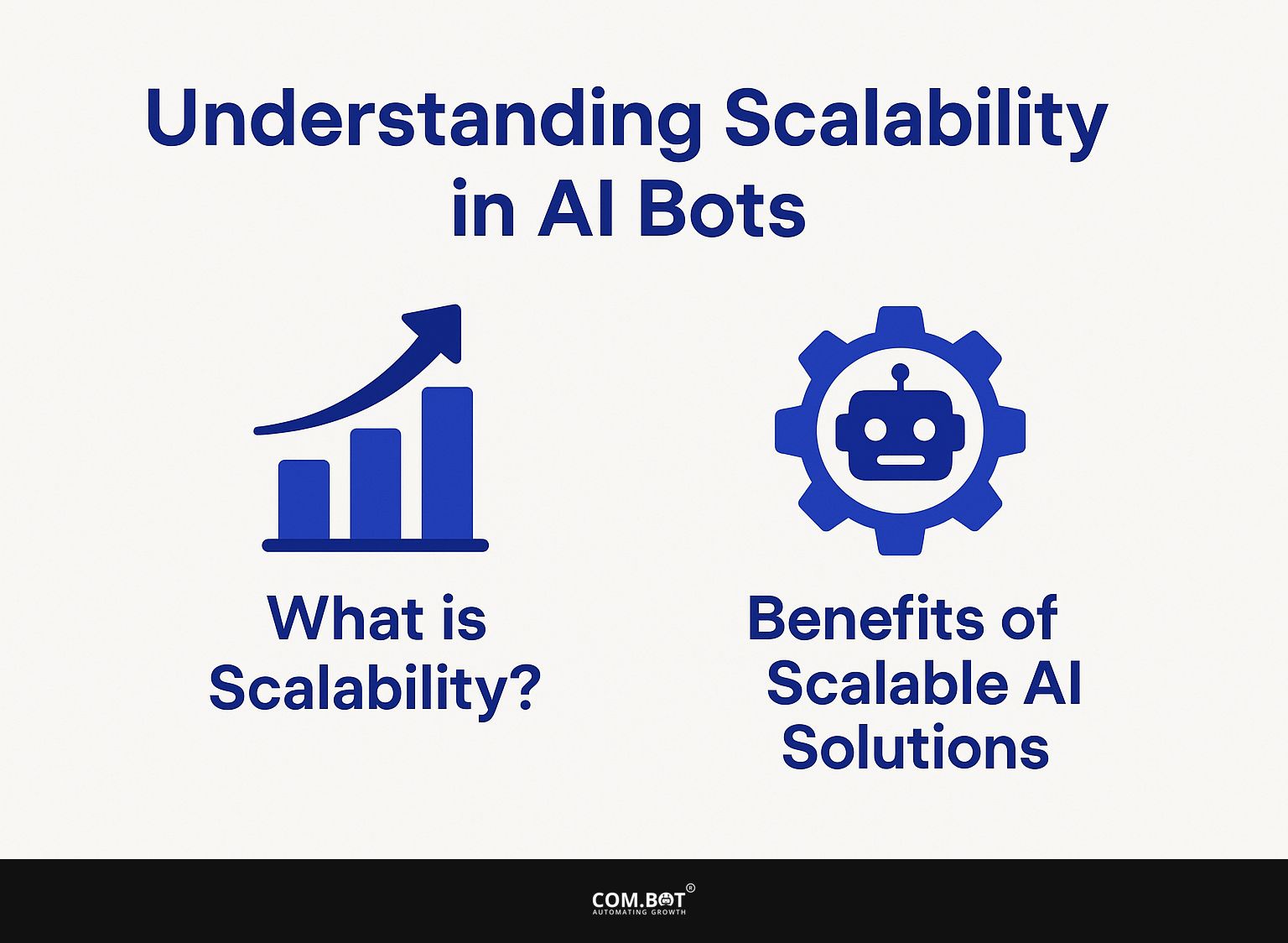
1. What is Scalability?
Scalability means a system, such as AI bots, can handle more users and work without losing quality. There are two primary types of scalability: vertical and horizontal.
Vertical scaling means increasing a server’s capability by upgrading its RAM or CPU power, so it can manage more requests. An example is a telecom company upgrading its chatbot’s server to increase response capacity during peak hours.
In contrast, horizontal scaling entails adding more servers to distribute the load, allowing a system to manage a growing number of interactions. This method is important for rapidly expanding businesses to make sure users have a smooth experience even as demand increases greatly.
2. Benefits of Scalable AI Solutions
Scalable AI solutions lead to cost efficiency by ensuring system performance is maintained, even as user volumes double or triple.
For instance, during peak sales events, e-commerce platforms using scalable AI have reported handling traffic spikes of up to 200% without service interruptions.
Tools like AWS Auto Scaling or Google Cloud’s Load Balancer automatically adjust resources based on real-time demand, minimizing operational costs while maximizing uptime.
Using AI chatbots can lower customer service expenses by handling basic questions, letting human staff deal with more complicated issues, which improves efficiency during busy times.
Efficiency Metrics for AI Bots
Assessing how well AI bots work is important to see how they affect business performance and how happy customers are with the service. For those interested in measuring these impacts, exploring the Com.bot Conversational Analytics Dashboard could offer valuable insights.
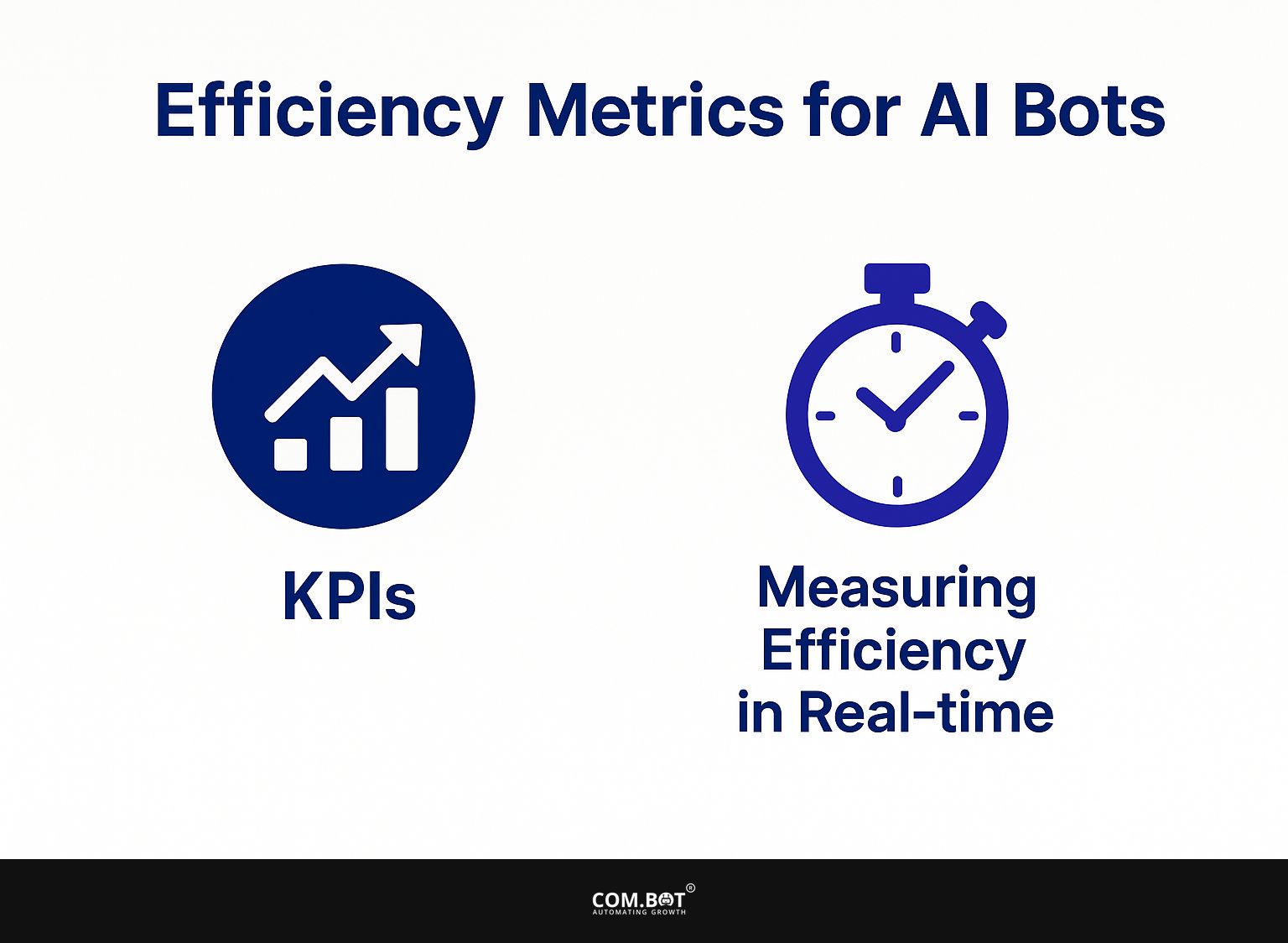
1. Key Performance Indicators (KPIs)
Key Performance Indicators (KPIs) for AI bots include metrics such as response times, resolution rates, and overall customer satisfaction scores. To keep an eye on these KPIs, set specific standards that match your industry.
For example, try to keep response time below 2 seconds to improve user experience. Implement tools like Google Analytics for interaction metrics and Zendesk for resolution rates.
Regularly review these KPIs at least once a month, adjusting your bot’s scripts and training data to improve underperforming areas. Running customer satisfaction surveys provides clear feedback, helping you change your approach to meet user needs.
2. Measuring Efficiency in Real-time
Real-time analytics tools like Chatbot Analytics enable businesses to monitor AI bot performance and make adjustments as necessary. By integrating Google Analytics with your chatbot, you can track user interactions, such as session duration and bounce rates.
For example, setting up event tracking for specific bot responses allows you to see which interactions drive engagement. Tools like Hotjar can show how users interact with your site using heatmaps and session recordings.
Regularly reviewing this data helps you adjust conversation paths or include common questions, which enhances user experience and increases conversion rates over time.
Implementing AI Bots for High Volume Tasks
To successfully use AI bots, it’s important to clearly know the right situations for their use and to smoothly connect them with current systems. Worth exploring: Rule-Based vs. AI Bots: Differences and Use Cases for a deeper understanding of optimal scenarios for AI bot deployment.
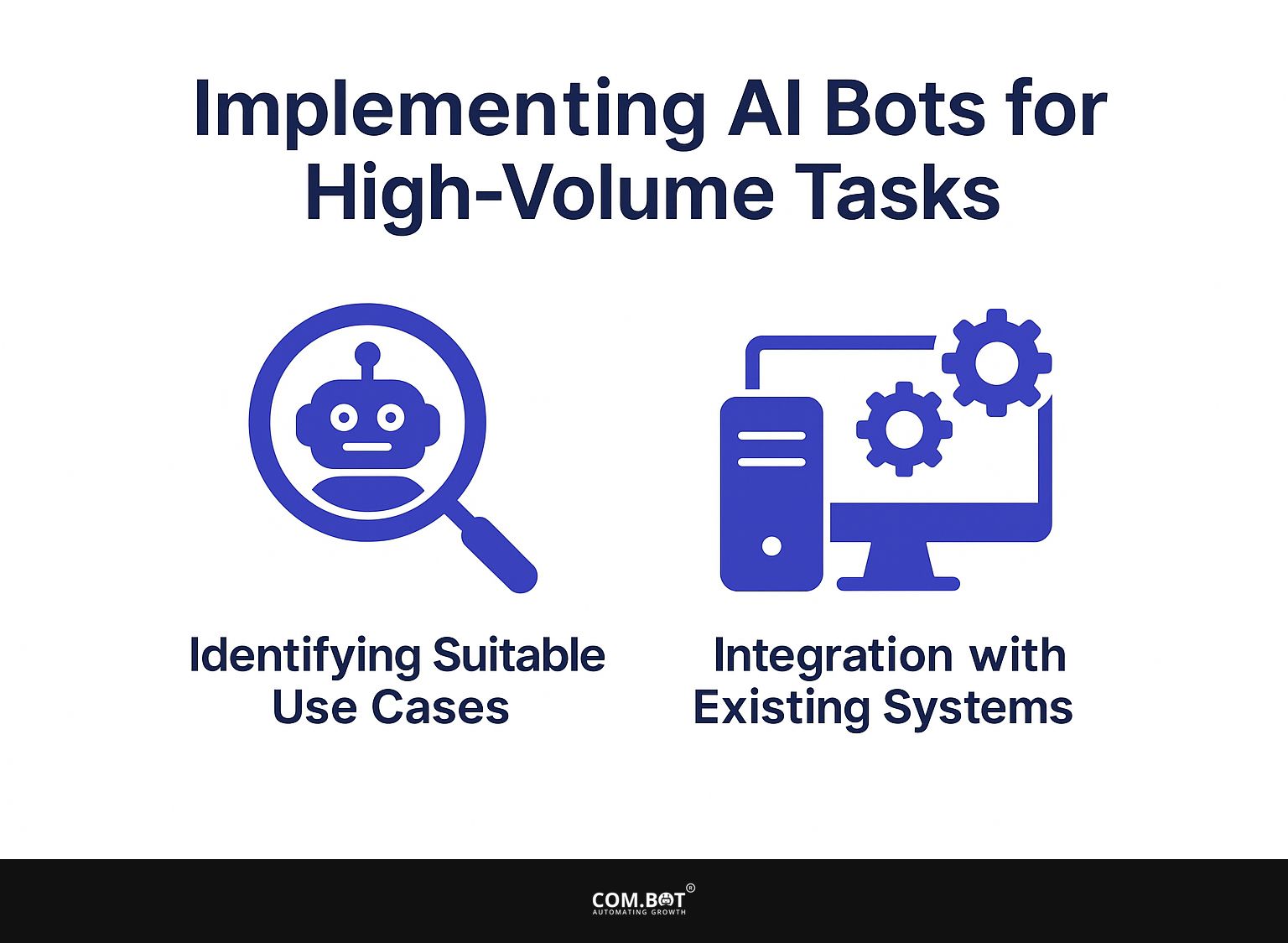
1. Identifying Suitable Use Cases
Common use cases for AI bots in high volume management include automating customer queries, processing orders, and providing real-time support. Many companies have successfully used AI bots to improve efficiency.
A luxury car brand introduced a chatbot to manage customer questions, cutting down response times from hours to just minutes. In the same way, an online shopping site added an AI tool to handle orders, which caused a 20% rise in conversion rates.
Tools like Zendesk and Drift allow businesses to set up chat interactions specifically suited to their requirements. This method makes processes more efficient and improves how happy customers are.
2. Integration with Existing Systems
Linking AI bots with existing systems through APIs can make operations more efficient and improve overall compatibility.
- To use AI bots effectively, begin by selecting the main tasks you want the bots to handle, such as customer service or data entry.
- Choose a reliable API management tool, such as Postman for testing or Zapier for automating workflows between apps.
- For example, if you’re using a chatbot on your website, link it to your CRM with an API to keep data current.
- Document your integration steps clearly, allowing for easier troubleshooting and adjustments as needed.
- This organized method improves the bot’s capabilities and matches it with your business goals.
Challenges in Managing High Volume with AI Bots
AI bots offer many benefits, but they also face some problems that can reduce their ability to handle lots of tasks.
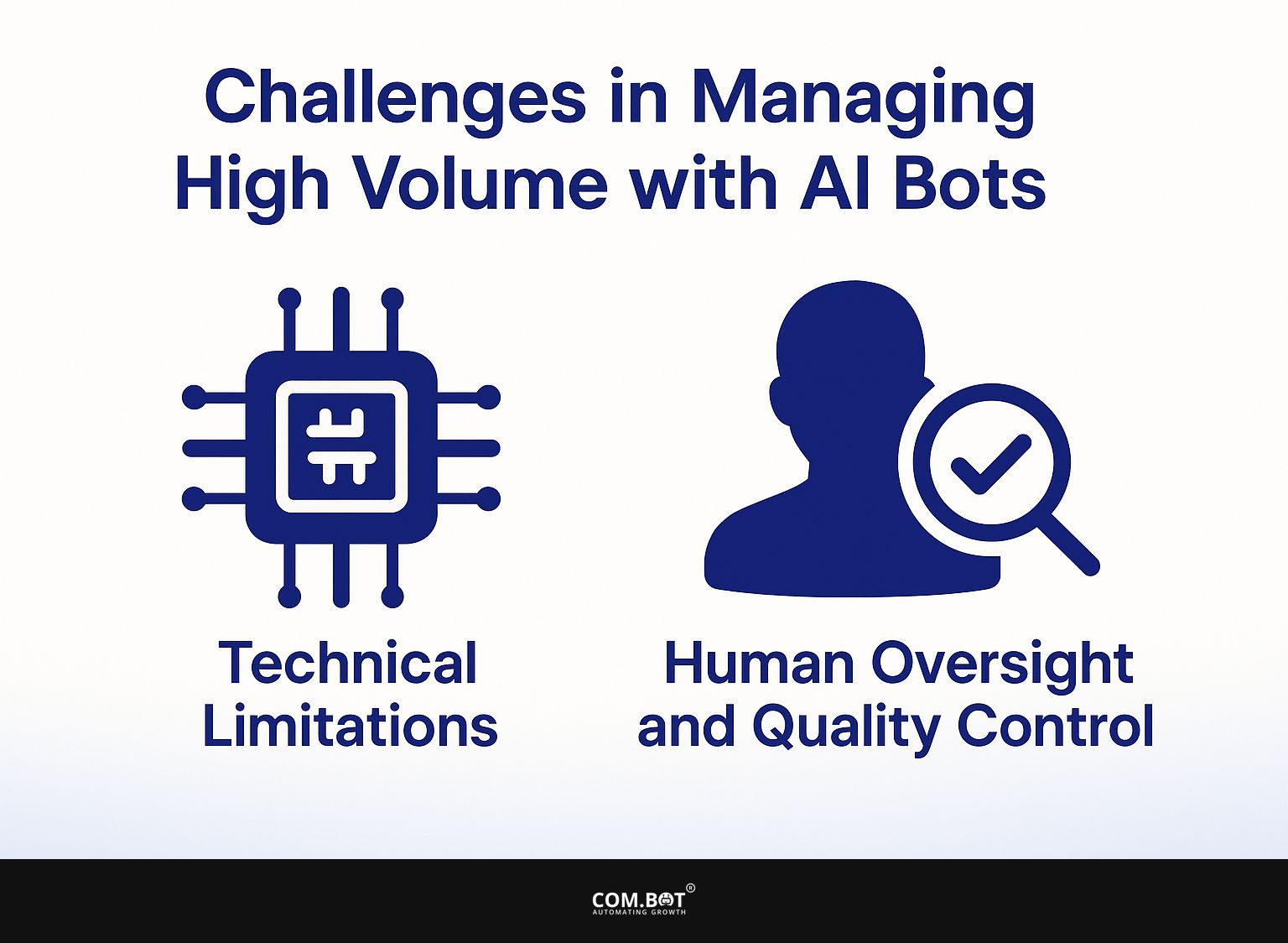
1. Technical Limitations
Technical limits like query capacity and performance drops can greatly affect how well AI bots work during high traffic. To address these issues, implement load balancing with tools like Nginx or AWS Elastic Load Balancer.
For example, if your bot becomes slower when many people use it, dividing the traffic across multiple servers can make it faster. Cache frequently requested data using Redis or Memcached to reduce the query load on your database.
Check your query performance regularly and adjust your database resources based on traffic to keep the user experience smooth, even when demand is high.
2. Human Oversight and Quality Control
Human oversight remains essential in ensuring that AI bots maintain quality control and deliver satisfactory customer experiences.
Regularly checking AI bots is important to improve how they work. For example, e-commerce giants like Amazon employ customer feedback to adjust their chatbots.
Tools such as Google Analytics can help track user interactions, allowing businesses to identify common issues. Using A/B testing can show which responses work best for users.
Regularly refreshing the bot’s details keeps it up-to-date, which improves its ability to answer customer questions accurately and boosts overall satisfaction.
Future Trends in AI Bot Scalability
The growth of AI bot scalability is highlighted by quick progress in technology, leading to expectations of broad use in various industries. This expansion is not only reshaping how businesses operate but also enhancing customer interactions significantly. In particular, AI Bots for Customer Support are transforming service delivery by improving efficiency and satisfaction, illustrating the tangible benefits of AI integration.
AI Bot Scalability Statistics
AI Bot Scalability Statistics
AI Bot Impact and Growth: AI Bot Usage and Adoption
AI Bot Impact and Growth: Market Growth and Trends
AI Bot Impact and Growth: AI Bot Efficiency
AI Bot Impact and Growth: Influence of AI Agents on Market
The AI Bot Scalability Statistics give a detailed summary of how AI chatbots are currently used, their growth, efficiency, and impact in the market, showing their growing importance in different industries. The data shows that many people are starting to use and recognize chatbots, which is changing how customers interact and how the market works.
AI Bot Usage and Adoption shows that 88% of businesses used chatbots in 2022, reflecting their integral role in modern customer service strategies. Consumer awareness of these bots is impressively high at 96%, indicating widespread familiarity. However, while 69% of customers reported satisfaction with their last chatbot interaction, there’s room for improvement in meeting user expectations. Interestingly, 62% of consumers prefer chatbots over human agents, showcasing a shift towards AI-driven interactions, possibly due to their efficiency and 24/7 availability.
The Market Growth and Trends section highlights the global chatbot market size, which reached $6.3 billion in 2023, with a slight projected decline to $1.953 billion by 2027. This projection suggests a possible market consolidation or recalibration. In contrast, retail spending on chatbots is expected to soar to $72 billion by 2028 This shows a major commitment to AI resources to improve how customers interact with us and to make our operations more efficient.
AI Bot Efficiency data shows that 79% of routine queries are effectively handled by chatbots, and they can offer a 30% reduction in customer support costs. Furthermore, 70% of chatbot conversations are managed from start to finish, demonstrating their capability to resolve issues without human intervention, thus enhancing the efficiency of support systems.
The Influence of AI Agents on Market reveals that 70% of US banking users frequently engage with chatbots, illustrating the sector’s reliance on AI for customer interactions. The projected global AI agent market size of $47 billion by 2025 Shows increasing confidence and use of AI technologies in different industries, highlighting their significant effect on business processes and interactions with customers.
Overall, the statistics show a steady and strong use of AI bots in many industries, providing significant improvements in efficiency and changing how customer service is delivered. As technology advances, better interaction quality and market growth seem likely.
1. Advancements in AI Technology
Recent advances in machine learning and AI that creates content are allowing AI bots to handle more tasks and work better, leading to improved interactions with users.
These improvements come from better natural language processing (NLP) methods, enabling bots to grasp situations and create responses that closely resemble those of humans.
For example, tools like OpenAI’s GPT-3 can create logical conversations that change according to what the user says. Integrating AI with platforms such as TensorFlow for model training on diverse datasets increases the bots’ ability to handle varied topics.
This combination improves customer service conversations and allows businesses to customize services, resulting in increased user satisfaction and engagement.
2. Predictions for Industry Adoption
Experts say that by 2025, AI bots will handle 75% of customer service talks, greatly changing how customers are served. Companies are using AI tools to better serve customers and customize experiences.
For example, using chatbots like Zendesk Chat can help answer typical questions quickly, so human agents can handle more complicated problems. Platforms like Salesforce Einstein enable predictive analytics to anticipate customer needs based on their behavior.
AI tools help businesses reply to customers faster and tailor experiences to individual needs. This approach helps build loyalty and satisfaction in a world where automation is growing.
Frequently Asked Questions
1. How can AI programs handle large amounts effectively?
AI bots can manage many tasks at the same time, making them perfect for handling large amounts of work. They can process and respond to inquiries in real-time, ensuring efficient and timely resolution of customer concerns.
2. What is the scalability of AI bots in managing high volume?
AI bots have the ability to handle a high volume of tasks without compromising speed or performance. They can easily scale up or down to meet the demand, ensuring efficient management of high volume.
3. Can AI bots handle complex tasks and still maintain efficiency in managing high volume?
Yes, AI bots are equipped with advanced technologies such as natural language processing and machine learning, allowing them to handle complex tasks with ease while maintaining efficiency in managing high volume.
4. How can AI bots be integrated into existing systems for managing high volume?
AI bots can be easily added to current systems, making it simple to include them in handling large-scale processes. This integration also allows for easy customization and personalization of the bots to suit specific business needs.
5. Are AI bots cost-effective in managing high volume compared to human employees?
Yes, AI bots can significantly reduce the costs associated with managing high volume. They need little upkeep and can manage more tasks, making them an affordable option for companies dealing with a lot of work.
6. Can AI bots improve the overall efficiency of managing high volume processes?
Absolutely. AI bots can handle tasks more easily and accurately, making fewer mistakes and improving the general process of dealing with large amounts of work. They can also provide important information that can help make processes more efficient and increase performance.
